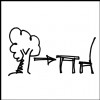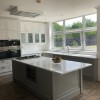
We design and make free-standing hardwood furniture and other pieces, specialising in the use of British-grown timbers. With over forty years' experience between us, both as part of Bates and Lambourne and now as BLAM, the range of our work has been wide and varied, from miniature coffins for Gulliver's Travels to a grass-roofed garden room, from chapel furniture bristling with daggers for the Royal Marines to an Oxford college's dining room chairs resplendent with carved totem animals.
The common thread through all is our commitment to the individual character of each piece and the belief that a satisfying end result can best be achieved through the equal satisfaction of its making.
The common thread through all is our commitment to the individual character of each piece and the belief that a satisfying end result can best be achieved through the equal satisfaction of its making.
Services
BLAM is the latest chapter in a long history of furniture making, a partnership between craftsmen Harry Williams and Josh Howard-Saunders.
Between us we have been making furniture for over forty years at the renowned Oxfordshire workshops of Bates and Lambourne, initially as informal apprentices and ultimately as directors of the company.
In 2020, we decided to continue the work of Bates and Lambourne under the condensed name of BLAM, as an opportunity to spend more time at the workbench actually being designers and makers and less time involved in the paperwork and other distractions that come with running a larger company.
Between us we have been making furniture for over forty years at the renowned Oxfordshire workshops of Bates and Lambourne, initially as informal apprentices and ultimately as directors of the company.
In 2020, we decided to continue the work of Bates and Lambourne under the condensed name of BLAM, as an opportunity to spend more time at the workbench actually being designers and makers and less time involved in the paperwork and other distractions that come with running a larger company.
Our workshops on The Camp Industrial Estate at Milton Common are housed in some of the last remaining parts of the local POW camp that was built to house Italian prisoners during WWII.
Between them and us, it was also used post-war as emergency housing, and then became a turkey farm.
Having originally set up in a workshop on Aston Hill in 1979, Bates and Lambourne were one of the first companies to move onto the site in the early 1980s, a few years after their founding.
Forty years on, the workshop, its benches and machines, its stacks of timber and components, feel as much a part of the landscape as the buildings themselves.
Between them and us, it was also used post-war as emergency housing, and then became a turkey farm.
Having originally set up in a workshop on Aston Hill in 1979, Bates and Lambourne were one of the first companies to move onto the site in the early 1980s, a few years after their founding.
Forty years on, the workshop, its benches and machines, its stacks of timber and components, feel as much a part of the landscape as the buildings themselves.
At the root of most of the chairs we design and make at BLAM, there are two distinct methods of construction.
The 'Windsor' style, that made High Wycombe and Stokenchurch a centre of furniture making in the days when Harry's grandfather and great-grandfather were chairmakers, is a fine example of design being guided by method.
The legs and back of the chair are fitted into the solid slab of the shaped timber seat and most of the joints are defined by being a round turned component fitted into a drilled round hole.
The 'Windsor' style, that made High Wycombe and Stokenchurch a centre of furniture making in the days when Harry's grandfather and great-grandfather were chairmakers, is a fine example of design being guided by method.
The legs and back of the chair are fitted into the solid slab of the shaped timber seat and most of the joints are defined by being a round turned component fitted into a drilled round hole.
Cabinets come in many forms.
Being generally further from the front line of daily heavy usage than tables and chairs, they are often more ornate and detailed, their purpose to store and display possessions.
Because they frequently have moving components such as drawers and doors, they tend to be more complex in construction.
Sometimes, as in display cabinets or jewellery cases, the cabinetwork is essentially subsidiary to its contents, taking on the role of plinth or picture frame around a cherished artwork.
Being generally further from the front line of daily heavy usage than tables and chairs, they are often more ornate and detailed, their purpose to store and display possessions.
Because they frequently have moving components such as drawers and doors, they tend to be more complex in construction.
Sometimes, as in display cabinets or jewellery cases, the cabinetwork is essentially subsidiary to its contents, taking on the role of plinth or picture frame around a cherished artwork.
Over the decades as Bates and Lambourne, and now as BLAM, it has been our good fortune to be presented with the opportunity to work on some truly unique projects, some little and quirky, some large and bizarre, some noble, others ludicrous.
Occasionally we indulge ourselves and follow a piece of wood to wherever it wants to go.
Amongst other things residing under the category of 'Other': a tortoise house, a gavel, a printing press based on that used by William Blake, furniture for the films Gladiator and Braveheart, sub-Hepworthian garden sculptures, and Josh's garden shed.
Occasionally we indulge ourselves and follow a piece of wood to wherever it wants to go.
Amongst other things residing under the category of 'Other': a tortoise house, a gavel, a printing press based on that used by William Blake, furniture for the films Gladiator and Braveheart, sub-Hepworthian garden sculptures, and Josh's garden shed.
Reviews

Be the first to review Bates & Lambourne.
Write a Review


